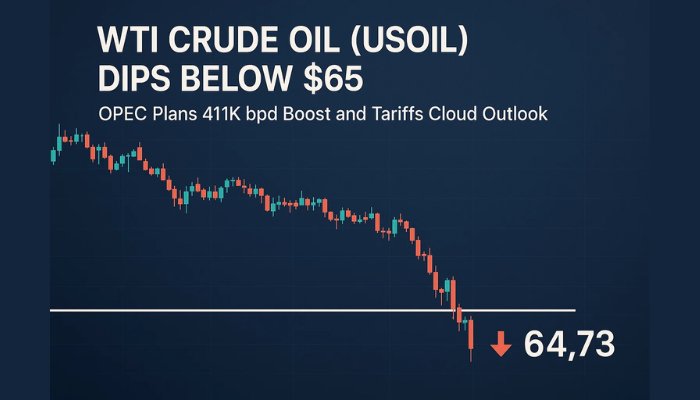WTI Succeeds in Maintaining the Previous Day’s Bullish Run-up – A Fundamental Outlook!
WTI Crude Oil stopped its bearish run-up of the previous day, taking fresh bids around well above the $ 43.00 level, mainly due to the...
Today, in the Asian trading session, WTI Crude Oil stopped its bearish run-up of the previous day, taking fresh bids around well above the $ 43.00 level, mainly due to the market risk-on sentiment, backed by the hopes of the US stimulus package, as the latest updates hint that the Democratic opposition is showing a willingness to go with the offer of $ 1.3 trillion.
On the flipside, the hopes of a coronavirus (COVID-19) vaccine also helped the market risk tone and contributed to the gains in crude oil. Factors on the positive side could be China’s upbeat official PMI data and Japan’s record hike in preliminary Industrial Production (MoM). In the meantime, the weakness of the broad-based US dollar, triggered by the combination of other factors, favored the oil bulls and contributed to the gains in oil.
On the contrary, the long-lasting tussle between the US and China over multiple issues could be considered the primary factor that is undermining the bullish sentiment surrounding crude oil. Furthermore, fears of oversupply and a lack of demand amid the rising number of coronavirus cases have become the key factors that are capping any further upside momentum in oil. At the moment, WTI Crude Oil is trading at 43.32 and consolidating in a range between 42.92 – 43.34.
As we have already mentioned, the sentiment around the crude oil prices got some additional support after the release of China’s upbeat official PMI data and Japan’s industrial production, which rekindled the demand for fuel. On the data front, China released data earlier in the day, suggesting a decline in the manufacturing Purchasers’ Managers Index (PMI) to 51 in August, against the 51.2 that was forecast, and lower than July’s PMI of 51.1. But the same data showed that the non-manufacturing PMI for August climbed to 55.2, exceeding July’s reading of 54.2.
On the other hand, Japan’s industrial production rose by 8%, month-on-month, in July, against anticipated growth of 5.8% and an increase of 1.9% in June. But retail sales saw a 2.8% drop, year-on-year, in the same month, however falling shy of the predicted decline of 1.7%, but nevertheless coming in smaller than the drop of 3.9% in June.
However, the market risk sentiment continues to draw support from the optimism over the coronavirus (COVID-19) vaccine/treatment, coupled with positive movements regarding the probabilities for the US stimulus package. As per the latest report, the Democratic opposition indicated that they would agree to an offer of $ 1.3 trillion. Apart from this, the risk-tone was further supported by US health official Dr. Fauci’s reports, that signal the likelihood of an early vaccine to halt the pandemic. Comments by Japanese diplomat Suga, that the deadly virus would end soon, also boosted hopes.
As a result, the market risk sentiment remained positive, with Wall Street hugging the buyers, and S&P 500 Futures hitting a record high, above 3,500. Moreover, the US 10-year treasury yields were flat, at around 0.72%.
On the contrary, the Sino-US tensions remained on board, thanks to US President Trump’s latest remarks that suggested an end to reliance on the Dragon Nation. The fears of further supply, mainly due to the increasing development of oil rigs, and concerns of receding demand from China, become the key factor that capped any further upside momentum for the crude oil prices. Saudi Arabia’s energy minister, Prince Abdulaziz bin Salman Al-Saud, said, at the weekend, that Saudi Aramco (SE:2222) had found 2-new oil and gas fields, the Abraq al-Toloul oil field and Hadabat al Hajara gas field, in the country’s northern regions.
On the USD front, the broad-based US dollar was down on the day in the Asian session this morning, due to the downbeat Core PCE data. Added to this, the Fed Chair’s Average Inflation Targeting (AIT) strategy, which allows inflation to rise above the 2.0% target, also weighed on the US dollar and extended support to the oil prices. However, the losses in the US dollar kept the oil prices higher, as the price of oil is inversely related to the price of the US dollar. Meanwhile, the US Dollar Index, which tracks the greenback against a basket of other currencies, dropped by 0.09%, to 92.293, on the day. Another negative factor could also be the rising number of coronavirus cases in America, Brazil and India, which are providing an ongoing challenge to the risk-on market sentiment. It’s worth reporting that, as of August 31, there are over 25.1 million COVID-19 cases globally, as per Johns Hopkins University data.
Looking ahead, the market traders will keep their eyes on the Japanese Unemployment Rate for fresh direction. In the meantime, Japan’s Final Manufacturing PMI will also be key to watch. In the meantime, the updates surrounding the fresh Sino-US tussle, this time over the South China Sea, coupled with coronavirus (COVID-19) updates, have not lost any significance. Good luck!
- Check out our free forex signals
- Follow the top economic events on FX Leaders economic calendar
- Trade better, discover more Forex Trading Strategies
- Open a FREE Trading Account


